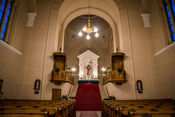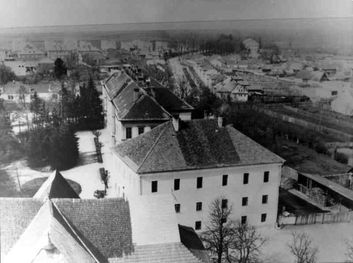The Wooden Articular Church / Die evangelische Holzirche
The wooden evangelical church was written into the List of the UNESCO World Heritage, within the scope of the enlistment of the Wooden Churches of the Slovak part of the Carpathian Mountain Area in 2008. Wooden Evangelical church is the national cultural treasure. The church comes from the time of religious bondage of Protestants. According to the assembly in Sopron the Protestants could build their churches only out of town walls without solid foundations, from wood, no towers and bells. The first church dates back to the years 1687-1688. Nowadays building is from the year 1717 and was built in incredibly short time- 3 months in baroque style. The church is sacred to the Holy Trinity. Protestants from the whole northern Europe financially supported the building. Swedish and Danish kings ordered whip-rounds in their countries to support the building of this church. The whip-rounds took 2, 5 year time. The surveyor of the church was Juraj Müttermann from Poprad, the artists were the Mayer and Kramer from Levoča. The organ was made by master Vavrinec Čajkovský from Levoča and Martin Korabinský from Spišská Nová Ves completed it. All woodcutting comes from the workroom of Ján Lerch from Kežmarok. There is a baroque altar with the Madonna under the Cross and with the statues of Moses and Aaron on the sides. Pulpit is made on the head of a gold-plated angel and on its façade are four statues of the evangelists. The font is made of sandstone with cupreous lid and comes from the year 1690 from the original old church. The wooden church also called “articular church” offers 1500 places to sit on the ground floor and six choirs. After the year 1990 got the Evangelical congregation back their property in Kežmarok and started with reconstruction. State and the town shared the costs of reconstruction in the height of 15 000 000.-Sk. 20% of costs brought the Carpathian Germans from Germany, Austria and USA through sponsors. The reconstruction of the organ was sponsored halfway by the government of Germany. Die evangelsiche Holzkirche wurde in die UNESCO-Liste in die Registrierungsdatei von Holzkirchen im slowakischen Teil der Karpaten im Jahr 2008 aufgeführt.
Die evangelsiche Holzkirche ist ein nationales Kulturdenkmal. Die Kirche stammt aus der Zeit der religiösen Unterdrückung der Protestanten. Sie durften gemäß dem Artikel 26 des Ödenburger Landtagsbeschlusses ihre Kirche nur außerhalb der Stadtmauer, ohne feste Grundmauern, aus Holz und ohne Turm und Glocken erbauen. Der erste Kirchenbau wurde schon in den Jahren 1687 - 1688 erstellt. Der heutige Bau wurde 1717 in der unglaublich kurzen Zeit von drei Monaten im Barockstil errichtet. Die Kirche ist der heiligen Dreieinigkeit geweiht. Protestanten aus ganz Nordeuropa haben den Bau finanziell unterstützt. Sowohl der schwedische wie auch der dänische König haben Spendensammlungen zu Gunsten des Kirchbaues in ihren Ländern angeordnet. Die Sammelaktion dauerte 2 1/2 Jahre. Der Baumeister der Kirche war Georg Müttermann aus Poprad/Deutschendorf. Als Kunstmaler werden die Leutschauer Mayer und Kramer genannt. Die Orgel wurde vom Leutschauer Orgelbauer Cajkovsky gefertigt und von Martin Korabinsky aus Zipser Neudorf vervollständigt. Alle Holzschnitzereinen stammen von Johann Lerch aus Kesmark. Der barocke Altar mit Maria unterm Kreuz wird von Moses und Aaron flankiert. Die Kanzel ruht auf einem vergoldeten Engel. An der Kanzelbrüstung erkennen wir die vier Evangelisten. Das Taufbecken aus Sandstein mit einer kupfernen Schüssel stammt aus der alten Kirche von 1690. Die Holzkirche - auch "Artikularkirche" genannt - bietet im Erdgeschoss und auf den sechs Emporen Sitzplätze für 1.500 Gläubige. Nach 1990 erhielt die evangelische Kirchengemeinde Kesmark ihr Eigentum wieder zurück und die Restaurierungsarbeiten wurden mit großem Einsatz in Angriff genommen. Der slowakische Staat, die Stadt Kesmark beteiligten sich an den Gesamtkosten von ca. 15 Millionen Slow. Kronen. 20% der Kosten brachten die Karpatendeutschen aus der BRD, aus Österreich und den USA durch Spenden auf. Die Orgel wurde zur Hälfte mit Mitteln der Bundesregierung saniert.
The New Evangelical Church / Neue Evangelische Kirche
In the second half of the 19th century the Protestants from Kežmarok decided to build a new church. A delegation of the congregation went to Vienna in 1870 to visit the regional architect /of Danish origin/ Teofil Hansen. He gifted the deputy with his own design, which was originally made for building a church in Orient. The project did not have an integral architecture in the framework of so-called eclectic style. We can find here Byzantine, Romanesque and Moorish elements. In all architectural elements dominates the precision symmetry, which reflected on building of two pulpits. The formal shovel was made in the year 1872 and in the year 1880 was the church under the roof. The lack of finances interrupted building for 11 years. The church was finished and consecrated in the year 1894. The church extended the mausoleum of Imrich Thökoly /1657-1705/ in the year 1909. Imrich Thökoly was born in Kežmarok and possessed the castle. He was a leader of an unsuccessful uprising against the Habsburgs and warrior for the religious parity. After his defeat he had to flee to Turkey where he died. His remains were transferred to Kežmarok in the year 1906.
In der 2. Hälfte des 19. Jahrhunderts entschieden sich die Kesmarker Protestanten für den Bau einer neuen Kirche. Eine Delegation der Kirchengemeinde besuchte 1870 in Wien den obersten Reichsarchitekten dänischer Herkunft, Theophil Hansen. Er schenkte der Kirchengemeinde Kesmark seine eigenen Entwürfe, die für einen Kirchenbau im Orient vorgesehen waren. Dieser Entwurf hatte keinen einheitlichen Baustil. Im Rahmen des sogenannten eklektischen Stils finden wir byzantinische, romanische und maurische Elemente. In allen Bauelementen herrschte eine genaue Symetrie, die sich auch in den zwei Kanzeln wiederspiegelt. Der feierliche Spatenstich fand 1872 statt und im Jahre 1880 war die Kirche schon überdacht. Wegen Geldmangels musste der Bau 11 Jahre ruhen und die Kirche konnte erst 1894 vollendet und eingeweiht werden. 1909 wurde an die Ostseite der Kirche ein Mausoleum für den Fürsten Imrich Thököly (1657-1705) angebaut. Er war gebürtiger Kesmarker und Besitzer der Burg. Als Führer des erfolglosen antihabsburgischen Aufstandes und Kämpfer für die religiöse Freiheit, floh er nach seiner Niederlage in die Türkei, wo er auch starb. 1906 wurden seine sterblichen Überreste nach Kesmark überführt.
The Evangelical Lyceum
& Library
The existence of the first town school in Kežmarok dates back to the years 1383-1392 /Latin school at the Holy Cross church/. Lyceum was built during the years 1774-1776. The extension of the building for two more floors gave the Lyceum current look /1820-1865/. After the reformation, yet in the year 1531, the school got the character of an evangelical grammar school. The academic classes were open in the years 1787-1852, together with the former school at the departments of philosophy, law and theology. The academic classes made the character of Lyceum and only a degree from the Lyceum allowed one to study at the university.
Many at the Lyceum in Kežmarok performed their profession, honored scientists educated the students from the whole central Europe. Many of them are known as reputable artists, scientists and writers of German, Slovak, Hungarian and Serbian nationality and it was a sign of the tolerance and outspokenness of this school. Many of well known personalities can document this, for example: Fröhlich, Buchholz, Šafárik, Hviezdoslav, Alexander, Genersich, Medňanský, Kazinczy and others.
The library in the Lyceum is the biggest school library in central Europe. Contains 150 000 titles in different languages, most of them are in German. There are also precious and significant incunables /from the time before the year 1500/ and incunabulum from the 16th century /Luther’s bible, Melanchton’s manuscripts and many others/.
Das evangelische Lyzeum und Die Lyzealbibliothek
Die Existenz einer Kesmarker Stadtschule wird erstmals in den Jahren 1383 - 1392 erwähnt (Lateinschule an der Kreuzkirche). Das Gebäude des Lyzeums wurde in den Jahren 1774 - 1776 errichtet. Durch Aufstockung mit zwei Stockwerken hat das Lyzeum sein heutiges Aussehen erlangt (1820 und 1865). Nach der Reformation, schon 1531, hatte die Schule den Charakter
eines evangelischen Gymnasiums. In Verbindung mit dieser Schule wurden 1787 - 1852 auch akademische Klassen mit den Lehrstühlen Philosophie, Rechtswissenschaft und Theologie eingerichtet. So erreichte die Schule den Rang eines Lyzeums.
Ohne Lyzealabschluss konnte man an keiner Universität studieren. In Kesmark wirkten angesehene Gelehrte und es studierten am Lyzeum Schüler aus ganz Mitteleuropa. Eine Reihe von ihnen wurden bedeutende Künstler, Gelehrte, Wissenschaftler
und Schriftsteller deutscher, slowakischer, ungarischer und serbischer Nationalität; ein Zeichen der Toleranz und Offenheit dieser Schule. Die Lyzealbibliothek ist die größte historische Schulbibliothek in Mitteleuropa. Sie umfasst 150.000 Bände in verschiedenen Weltsprachen, die meisten in deutscher Sprache. Darunter sind wertvolle und bedeutende Erstdrucke aus der Zeit vor 1500 und aus dem 16. Jh. (u.a. Lutherbibeln, Schriften von Melachton). Am Lyzeum studierten und wirkten bekannte Persönlichkeiten u.a. Fröhlich, Buchholz, Safarik Hviezdoslav, Alexander, Genersich, Mednansky, Kazinczy.











































































